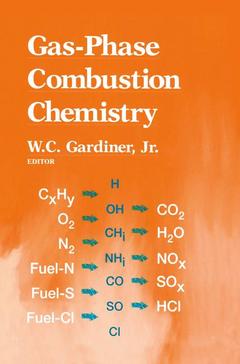1. Combustion Chemistry Modeling.- 1.1. Introduction.- 1.1.1 Terms used in dynamic modeling of chemical reaction.- 1.1.2 Chain reactions.- 1.1.3 Reaction rates, rate laws, and rate coefficients.- 1.1.4 Model constraints.- 1.1.5 Differential equations of chemical reaction without transport.- 1.1.6 Methods of numerical integration.- 1.1.7 Sensitivity and flux analysis of reaction profiles.- 1.2. Oxidation of hydrogen and carbon monoxide.- 1.2.1 Hydrogen oxidation at high temperatures.- 1.2.2 Role of peroxides at low temperatures.- 1.2.3 Carbon monoxide oxidation.- 1.2.4 Rate coefficients of the rate-limiting steps of H2and CO oxidation.- 1.3. Hydrocarbon combustion chemistry.- 1.3.1 General features of hydrocarbon oxidation.- 1.3.2 Low-and intermediate-temperature oxidation.- 1.3.3 High-temperature oxidation.- 1.3.4 Combustion of higher hydrocarbons.- 1.4. Nitrogen, sulfur, and halogens in flames.- 1.4.1 Oxidation of ammonia and hydrogen cyanide.- 1.4.2 Formation and destruction of nitrogen oxides in flames.- 1.4.3 Chemistry of NOxcontrol methods.- 1.4.4 Sulfur.- 1.4.5 Halogens.- 1.5. Combustion of alternative fuels.- 1.5.1 Methanol.- 1.5.2 Ethanol.- 1.5.3 Higher alcohols and MTBE.- 1.6. Combustion inhibitors.- 1.7. Combustion promoters.- 1.8. Reduced chemistry models of combustion.- 1.8.1 One-step chemistry.- 1.8.2 The steady-state approximation and global reaction models.- 1.8.3 Empirically derived global mechanisms.- 1.8.4 Automated mechanism reduction by sensitivity analysis.- 1.8.5 Generalized mechanisms: Combustion chemistry in outline form.- 1.8.6 Local linearization and eigenvalue analysis.- 1.8.7 Algebraic representation of databases generated from detailed models: Repro-models.- 1.8.8 Chemical lumping methods.- 1.9. Resources for combustion chemistry modeling.- 1.9.1 Elementary reaction rate coefficient data.- 1.9.2 Validated reaction mechanisms.- 1.9.3 Combustion modeling software.- 1.9.4 Notes on the mechanism used in this chapter.- 1.10. References.- 2. Combustion Chemistry of Nitrogen.- 2.1. Introduction.- 2.2. Overview of nitrogen chemistry.- 2.2.1 Thermal, or Zeldovich, NO.- 2.2.2 Prompt, or Fenimore, NO.- 2.2.3 The N2O pathway.- 2.2.4 Fuel nitrogen.- 2.2.5 The NNH mechanism.- 2.2.6 Effects of temperature and pressure.- 2.2.7 NO reduction.- 2.3. Unimolecular and chemically activated bimolecular reactions.- 2.3.1 Unimolecular reactions.- 2.3.2 Pressure-dependent bimolecular reactions.- 2.3.3 Quantum Rice—Ramsperger—Kassel theory.- 2.3.4 Implementation of QRRK theory.- 2.4. Analysis of hydrogen atom abstraction reactions.- 2.5. Updated rate coefficients for the H/N/O system.- 2.5.1 O + N2? N + NO.- 2.5.2 NO + Ar ? N + O + Ar.- 2.5.3 N2O + Ar ? N2+ O + Ar.- 2.5.4 O + N2O ? Products.- 2.5.5 NH3+ Ar ? NH2+ H + Ar.- 2.5.6 NH3+ H ? NH2+ H2.- 2.5.7 NH3+ OH ? NH2+ H2O.- 2.5.8 NH3+ O ? NH2+ OH.- 2.6. QRRK treatments.- 2.6.1 H + NH2? NH + H2.- 2.6.2 HO2+ NO ? NO2+ OH.- 2.6.3 H + N2O ? Products.- 2.6.4 H + N2O ? N2+ OH and H + N2O ? HNNO.- 2.6.5 H + N2O ? NH + NO.- 2.6.6 H + N2O ? NNH + O.- 2.6.7 NH + NO ? Products.- 2.6.8 NH + O2? Products.- 2.6.9 NH2+ O2? Products.- 2.6.10 NH2+ HO2? Products.- 2.6.11 NH2+ O ? Products.- 2.6.12 NH2+ OH ? Products.- 2.6.13 NH2+ NH2? Products.- 2.6.14 NH2+ NO ? Products.- 2.6.15 CH3+ NO ? Products.- 2.6.16 CH3+ N ? Products.- 2.6.17 CH3+ NH2? Products.- 2.6.18 CH2+ N2? Products.- 2.6.193CH2+ NO ? Products.- 2.6.20 CH + N2? Products.- 2.6.21 CH + NO ? Products.- 2.7. Other reactions of interest.- 2.7.1 Reactions of N atoms.- 2.7.2 Reactions of NH.- 2.7.3 Reactions of NNH.- 2.7.4 Reactions of N2H2.- 2.7.5 Reactions of H2NN.- 2.7.6 Reactions of N2H3.- 2.7.7 Reactions of N2H4.- 2.7.8 Reactions of NO.- 2.7.9 Reactions of NO2.- 2.7.10 Reactions of N2O.- 2.7.11 Reactions of HNO.- 2.7.12 Reactions of NH2O.- 2.7.13 Reactions of HNOH.- 2.7.14 Reactions of1HNOO.- 2.7.15 Reactions of HONO.- 2.7.16 Reactions of HNO2.- 2.7.17 Reactions of HCN.- 2.7.18 Reactions of HNC.- 2.7.19 Reactions of CN.- 2.7.20 Reactions of H2CN.- 2.7.21 Reactions of HCNH.- 2.7.22 Reactions of HCNN.- 2.7.23 Reactions of H2CNH.- 2.7.24 Reactions of CH3NH.- 2.7.25 Reactions of CH2NH2.- 2.7.26 Reactions of CH3NH2.- 2.7.27 Reactions of NCCN.- 2.7.28 Reactions of NCO.- 2.7.29 Reactions of HCNO.- 2.7.30 Reactions of HOCN.- 2.7.31 Reactions of HNCO.- 2.7.32 Reactions of CH2NO.- 2.7.33 Reactions of CH3NO.- 2.7.34 Reactions of HON.- 2.7.35 Reactions of HCOH.- 2.7.36 Reactions of NH2OH.- 2.7.37 Reactions of NH2NO.- 2.7.38 Reactions of H2NNHO.- 2.7.39 Reactions of CINO.- 2.8. Illustrative modeling results.- 2.8.1 Ammonia oxidation.- 2.8.2 Kinetics of selective noncatalytic reduction of NO.- 2.8.3 Fuel-rich ammonia flames.- 2.8.4 Implications of the O + NNH reaction.- 2.8.5 Nitrogen chemistry in hydrocarbon—air flames.- 2.8.6 General conclusions from modeling tests.- 2.9. Summary.- 2.10. Acknowledgments.- 2.11. References.- 3. Kinetics and Mechanisms of the Oxidation of Gaseous Sulfur Compounds.- 3.1. Introduction.- 3.2. Sulfur emissions.- 3.3. Elementary reactions.- 3.3.1 Reactions of atoms and radicals with sulfur-containing molecules.- 3.3.2 Sulfur radical reactions.- 3.3.3 Sulfuric acid formation.- 3.4. Basic chemistry of sulfur in combustion environments.- 3.4.1 Hydrogen—oxygen flames.- 3.4.2 Hydrocarbon flames.- 3.4.3 Sulfur—nitrogen interactions.- 3.4.4 Sodium—sulfur interactions.- 3.4.5 Sulfur reaction studies in shock tubes.- 3.5. Thermochemistry of sulfur-containing compounds.- 3.6. Observations and conclusions.- 3.6.1 Elementary reactions.- 3.6.2 High-temperature studies.- 3.7. Acknowledgments.- 3.8. References.- 4. Survey of Rate Coefficients in the C-H-Cl-O System.- 4.1. Introduction.- 4.2. Electronic structure and thermochemistry.- 4.3. Characteristic features of elementary reactions of chlorine.- 4.4. Reaction mechanisms.- 4.5. Survey of elementary reactions.- 4.5.1 Reactions of H atoms.- 4.5.2 Reactions of O atoms.- 4.5.3 OH radical reactions.- 4.5.4 Reactions of Cl atoms.- 4.5.5 Reactions of Cl2.- 4.5.6 Unimolecular and pressure-dependent bimolecular reactions.- 4.5.7 Reactions of large molecules and radicals.- 4.6. Data gaps and suggestions for future work.- 4.7. Acknowledgments.- 4.8. References.- 5. Ideal Gas Thermochemical Data for Combustion and Air Pollution Use.- 5.1. Introduction.- 5.2. Thermochemical database.- 5.3. Sources of thermochemical data.- 5.4. Thermochemical polynomials.- 5.5. Calculation procedures.- 5.6. Accuracy of the database.- 5.7. Accuracy of standard enthalpies of formation.- 5.8. Other sources of thermochemical data.- 5.9. Format of the database.- 5.10. Conversion factors.- 5.11. Internet transfer of the database.- 5.12. References.- 5.13. Table of standard enthalpies of formation.




